.

Indoor vs Outdoor Weed: Which Is Better?
What makes indoor buds different from outdoor ones? Does exposure to sunlight and higher levels of microorganisms really make a difference? While gifted growers can cultivate high-quality cannabis almost anywhere, growing outdoors offers some significant benefits that are harder to obtain in sealed tents under artificial lights.
Contents:
If you’ve ever grown cannabis before, you’ll know a thing or two about how the environment impacts the genetic expression of a plant. The seemingly basic decision of growing weed indoors or outdoors actually has a significant impact. Flowers that develop in the controlled environment of a grow tent display telltale differences to those raised under the open sky.
Before we begin, we should note that the differences aren’t as clear-cut as you might imagine. There are many different variables to take into account. For example, an indoor grower using 500W lamps and top-tier organic nutrition will experience different results to someone using a low-powered desk light and no feed at all. The same remains true outdoors; a grower in southern Spain with an automated irrigation system will likely produce superior flowers to one growing in the northwest of England in high humidity and under cloudy skies.
Genetics, growing skill, and equipment aside, a few obvious signs remain that enable you to tell an indoor flower from an outdoor one. The fundamental characteristics of these two contrasting environments mean these differences almost always express themselves.
How Do Indoor and Outdoor Weed Compare?
What comes to mind when you compare an indoor marijuana plant against an outdoor one? Most think about size. The lack of ceilings, floors, and walls means large, tree-like plants can grow outward in all directions outside. Logically, this leads to bigger buds! But the divergence between the two doesn’t stop there. Differences in sunlight exposure, microbial communities, and temperature result in different flavours, colours, and even effects.
Below, you’ll discover the key traits of indoor vs outdoor weed. Plus, you’ll be able to confidently stroll into a coffeeshop or dispensary and flex your keen eye.
What Are the Differences in Colour?
In general, cannabis flowers grown outdoors display darker shades of green compared to those cultivated indoors. On top of appearing darker, outdoor cannabis buds often have a worn and sun-baked look that makes them lose some of their colour. Enduring the beating sun, howling winds, and lashing rains over the growing season creates a weathered look.
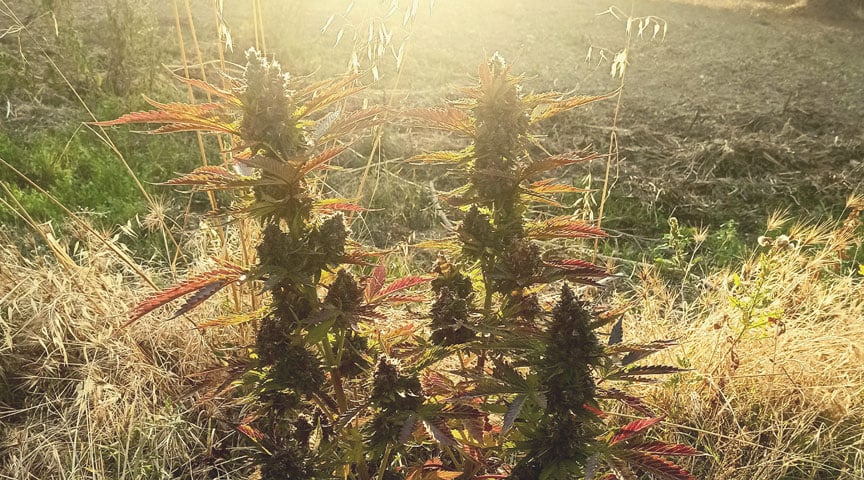
These aesthetic changes are dependent upon the environment, and change from one location to another. Flowers grown under the intense sun of Southern California appear more brown and baked than those further north. Indoor plants have it easy in comparison. They maintain their bright and vivid shades of green in the comfort of growing rooms, away from excess light exposure and tough weather conditions.
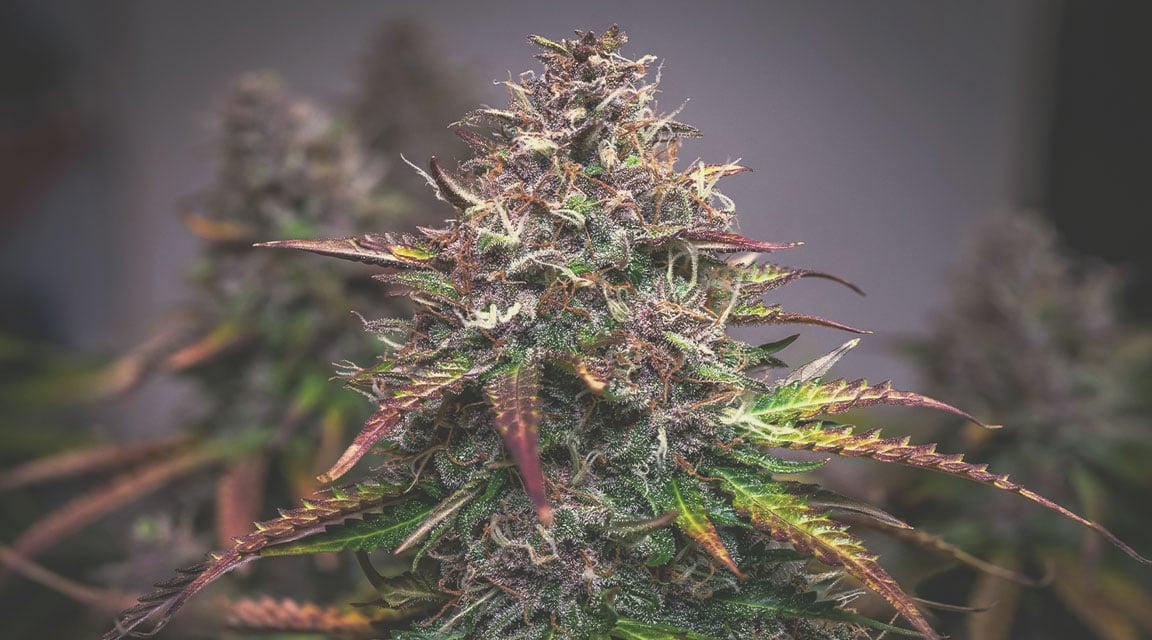
Cannabis plants appear green because of the photosynthetic pigment chlorophyll. However, some cultivars possess high levels of pigments known as anthocyanins, giving them a purple or red appearance. Although genetics underpins anthocyanin expression to a large degree, cooler nighttime temperatures outdoors lend to a darker and more striking tone.
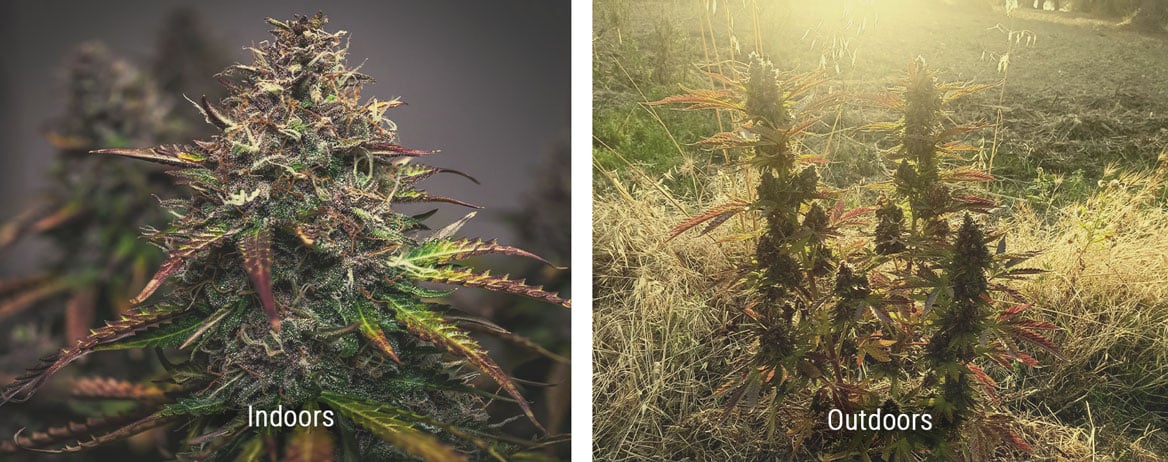
What Are the Differences in Size?
Size serves as one of the most obvious ways to tell indoor and outdoor buds apart. As a general rule, outdoor plants grow bigger than their indoor counterparts. Of course, there are exceptions, but in most cases, outdoor specimens have more room to spread their roots underground and expand their canopies above ground.
Extensive root systems ferry more nutrients into plants, and large and more abundant fan leaves drive photosynthesis through the roof. This perfect storm allows outdoor plants to capitalise on their situation and churn out larger, chunkier buds.
Depending on how manicured the buds are, you can also look to the branches for answers. Outdoor plants develop thicker, sturdier stems and branches than their indoor counterparts; partly because they grow larger in general, and partly as an adaptation to wind stress.
Indoor buds are typically smaller and denser due to the constraints of containers and growing tents. But size doesn’t always equal quality. Growers produce large hauls of dense, compact buds indoors year after year, which get them just as stoned as larger outdoor flowers.
What Are the Differences in Flavour?
Genetics, nutrition, and growing experience hold great influence over the flavour profile of a cannabis variety. But simply choosing to grow a cannabis plant indoors or outdoors can sway the taste of your buds more than anything else. Why? Sunlight and microorganisms play a large role.
-
Light
Artificial lights used by indoor growers are perfectly capable of growing fantastic cannabis flowers. While most don’t emit ultraviolet (UV) light, some models are equipped with UV bulbs that partially mimic the rays of the sun. Of course, outdoor plants are exposed to this form of light by default, and more of it. UV rays are divided into three categories based on their wavelengths:
| UVA | Makes up 3% of photons in sunlight that penetrates the Earth’s atmosphere, and isn’t harmful to plants |
| UVB | Makes up around 0.15% of the sunlight that reaches Earth; damages plant DNA |
| UVC | Highly destructive to DNA; likely none makes it through the atmosphere |
| UVA |
|
Makes up 3% of photons in sunlight that penetrates the Earth’s atmosphere, and isn’t harmful to plants |
| UVB |
|
Makes up around 0.15% of the sunlight that reaches Earth; damages plant DNA |
| UVC |
|
Highly destructive to DNA; likely none makes it through the atmosphere |
Although UV radiation is crucial to life on Earth, it does some damage. Different organisms have developed strategies to protect themselves from these wavelengths of light. Human skin develops a protective layer of melanin, whereas cannabis plants shield themselves from UV radiation with their own form of sunscreen; resin loaded with secondary metabolites such as aromatic terpenes. These molecules underpin the many flavours within cannabis, including those of fruit and earthiness.
Some indoor growers use lights that emit UVA radiation. The light within this wavelength helps to encourage terpene production without the harmful effects of UVB exposure. UVA radiation boosts secondary metabolite production in some plant species, meaning indoor growers can mimic the power of the sun, but only if they invest in UVA-emitting bulbs.
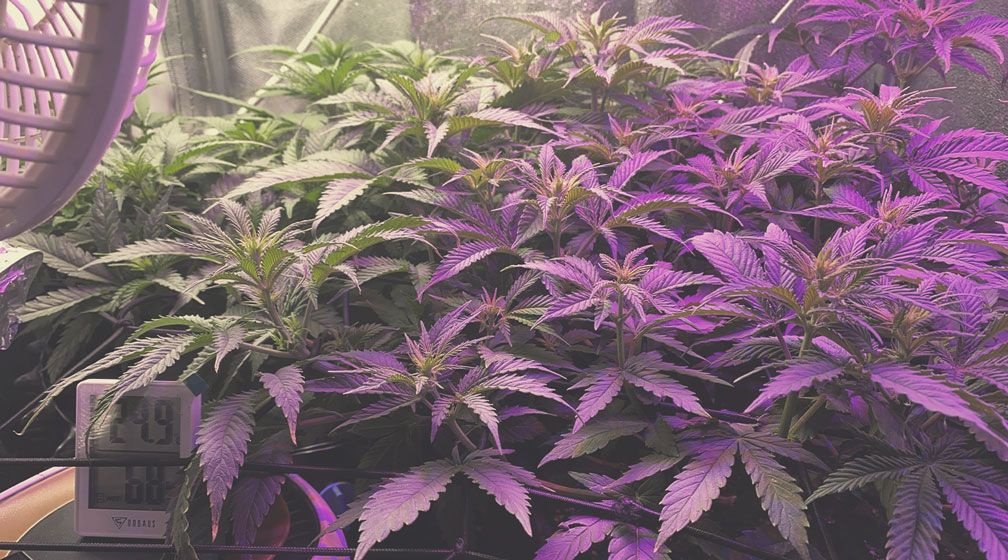
However, flowers grown outdoors often provide superior flavour because of UVB exposure. Although this increases the chance of DNA damage, this type of radiation may further increase secondary metabolite production, and therefore give rise to tastier buds.[2]
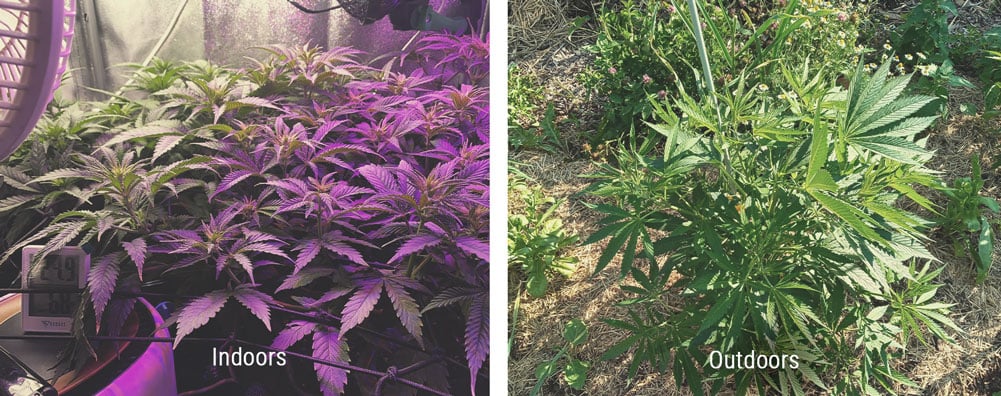
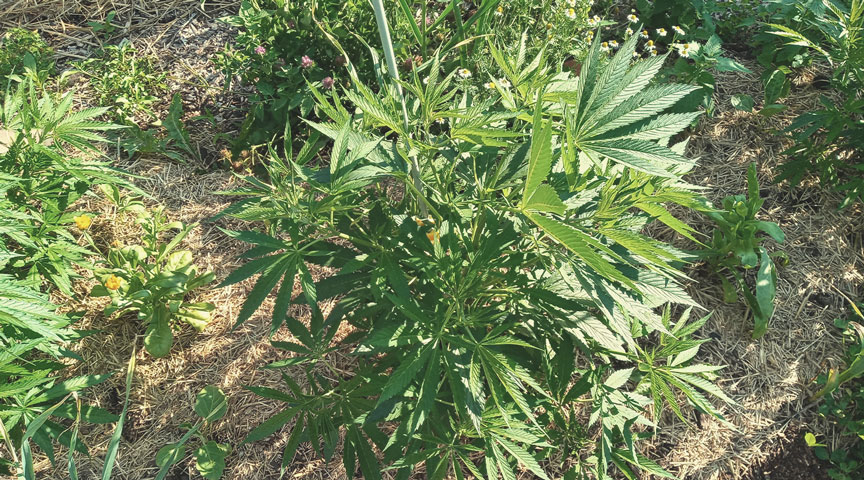
-
Microorganisms
But sunlight isn’t the only factor that endows outdoor flowers with more scrumptious flavours. A richer diversity of microbial life in well-established garden beds also helps to drive terpene levels through the roof. Beds that receive plenty of compost, mulch, and organic matter are havens for beneficial microbial fungi and bacteria, and contain a developed soil food web compared to indoor containers filled with young potting soil.
Among these species, arbuscular mycorrhizae form a synergistic relationship with cannabis roots. They act as an extension of the root system and ferry in nutrients from afar, in return for plant sugars created during photosynthesis. Once they form a relationship, they nudge plants into producing increased concentrations of terpenes to defend themselves against predators.[3]
From a human perspective, this means tastier and more aromatic cannabis flowers. Indoor growers can introduce beneficial fungi into their growing setup, but it will take some time to develop the microbial diversity and richness present in outdoor organic beds.
The concept of terroir also applies to outdoor weed. The French phrase “goût de terroir”, meaning “taste of the land”, suggests that many outdoor variables impart unique plant traits based on location. The climate, soil, elevation, and geomorphology of a particular place imprint themselves into the phytochemical profile of a plant, including the terpene content.
What Are the Differences in Potency and Effects?
Growing outdoors can influence the flavour of cannabis flowers, but can it really alter their effects? A host of cannabis phytochemicals underpin the effects of cannabis. While THC and CBD get most of the attention, many cannabis terpenes also bind to cannabinoid receptors and synergise with cannabinoids to alter the effects of a cultivar (by way of the entourage effect).[4]
We know that sunlight is a boon for terpene production and secondary metabolite synthesis in general. Cannabinoids also autumn into this chemical category. They don’t contribute toward the growth and reproduction of the cannabis plant, but they do help to defend it against environmental stress—including UV rays. Exposure to UVB helps to drive THC levels in cannabis. This means outdoor growers that are equipped with genetics expressing high quantities of THC can push their crop to the psychoactive limit.[5]
What Are the Differences in Quality?
Ultimately, you can grow top-tier cannabis in most environments, as long as you have good genetics, healthy soil, and a little knowledge. While outdoor settings offer natural sunlight and an abundance of microorganisms, indoor grow rooms allow for almost total control over environmental factors. Outdoor buds grow larger, but some of the best weed available stems from indoor growing operations. Instead of comparing indoor weed vs outdoor weed, learning to tell the difference between high and low-quality buds remains much more important!
- Frontiers | UVA Radiation Is Beneficial for Yield and Quality of Indoor Cultivated Lettuce | Plant Science https://www.frontiersin.org
- (PDF) UV-B Radiations and Secondary Metabolites https://www.researchgate.net
- Terpenoids in plant and arbuscular mycorrhiza-reinforced defence against herbivorous insects | Annals of Botany | Oxford Academic https://academic.oup.com
- Taming THC: potential cannabis synergy and phytocannabinoid-terpenoid entourage effects - PubMed https://pubmed.ncbi.nlm.nih.gov
- UV-B radiation effects on photosynthesis, growth and cannabinoid production of two Cannabis sativa chemotypes - PubMed https://pubmed.ncbi.nlm.nih.gov











































